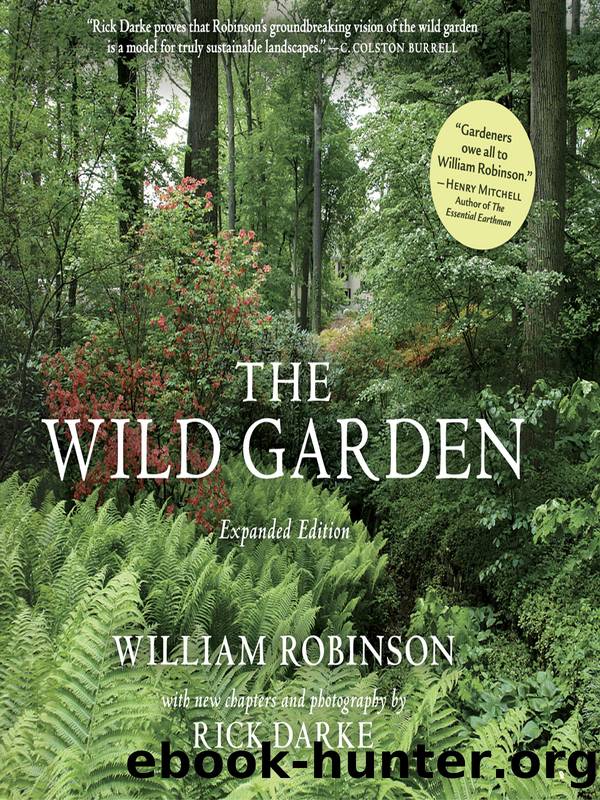The Wild Garden by Rick Darke

Author:Rick Darke
Language: eng
Format: epub
Publisher: Timber Press
Published: 2009-07-14T16:00:00+00:00
Sun roses (Cistus) and other exotic hardy plants among heather, on sandy slope in Surrey.
True taste in the garden is, unhappily, much rarer than many people suppose. No amount of expense, rich collections, good cultivation, large gardens, and plenty of glass will suffice. A garden of a few acres showing a real love of the beautiful in Nature, as it can be illustrated in gardens, is rare; and when it is seen it is often rather the result of accident than of design. This is partly owing to the fact that the kind of knowledge one wants in order to form a really beautiful garden is very uncommon. No man can do so with few materials. It is necessary to have some knowledge of the wealth of beauty which the world contains for our gardens; and yet this knowledge must not have a leaning, or at any rate but a very partial leaning, towards the Dryasdust.1 The disposition to ‘dry’ everything, to concern oneself entirely with nomenclature and classification, is not the gardening spirit—it is the life we want.
The garden of the late Mr. Hewittson, at Weybridge, had some of the most delightful garden scenes. Below the house, on the slope over the water of Oatlands Park, and below the usual lawn beds and trees, there is a piece of heathy ground—charming beyond any power of the pencil to show. The ground was partially clad with common Heaths with little green paths through them, and naturalized in the warm sandy soil were the Sun Roses which are shown in the foreground of the engraving. Here and there among the Heaths, creeping about in a perfectly natural-looking fashion, too, was the Gentian-blue Lithospermum prostratum. Among these groups were the large Evening Primroses and Peruvian Lily (Alstrœmeria), the whole relieved by bold masses of flowering shrubs, so grouped as not to show a trace of formality. All this was done without in the least detracting from the most perfect keeping. The garden is more free from offensive geometrical-twirling, barren expanse of gravelled surface, and all kinds of puerilities—old-fashioned and new-fangled—than any garden I have seen for years.
The following, from a correspondent, shows what may be done with few advantages as to space or situation:—
‘We have a dell with a small stream of spring water running through it. When I first came to Brockhurst I found this stream carried underground by a tile culvert, and the valley sides covered with Rhododendrons, the soil between carefully raked and kept free from weeds, so that it was only during springtime that flowers relieved the sombre effect of this primness. After five years this has all been changed into what I think you would call a wild garden, and we have cheerfulness and beauty all the year round.
‘In the first place the brooklet was brought to the surface, and its course fringed with marsh plants, such as Marsh Marigolds, Forget-me-nots, Celandines, Irises, Primroses, and Ranunculuses, together with Osmundas, Hart’s-tongues, and other Ferns. Many large-growing Carex and large Rushes are also here.
Download
This site does not store any files on its server. We only index and link to content provided by other sites. Please contact the content providers to delete copyright contents if any and email us, we'll remove relevant links or contents immediately.
The Lonely City by Olivia Laing(4120)
Animal Frequency by Melissa Alvarez(3755)
All Creatures Great and Small by James Herriot(3515)
Walking by Henry David Thoreau(3234)
Exit West by Mohsin Hamid(3183)
Origin Story: A Big History of Everything by David Christian(3139)
COSMOS by Carl Sagan(2950)
How to Read Water: Clues and Patterns from Puddles to the Sea (Natural Navigation) by Tristan Gooley(2853)
Hedgerow by John Wright(2776)
The Inner Life of Animals by Peter Wohlleben(2765)
Origin Story by David Christian(2683)
How to Read Nature by Tristan Gooley(2665)
Project Animal Farm: An Accidental Journey into the Secret World of Farming and the Truth About Our Food by Sonia Faruqi(2660)
How to Do Nothing by Jenny Odell(2645)
A Forest Journey by John Perlin(2587)
Water by Ian Miller(2582)
The Plant Messiah by Carlos Magdalena(2453)
A Wilder Time by William E. Glassley(2363)
Forests: A Very Short Introduction by Jaboury Ghazoul(2335)
